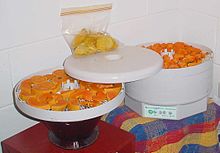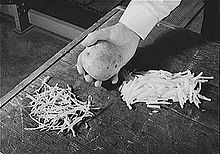- Drying (food)
-
 This electric food dehydrator has a hot air blower that blows air through trays with foods on them. Pictured are mango and papaya slices being dried.
This electric food dehydrator has a hot air blower that blows air through trays with foods on them. Pictured are mango and papaya slices being dried.
Drying is a method of food preservation that works by removing water from the food, which inhibits the growth of microorganisms and hinders quality decay. Drying food using sun and wind to prevent spoilage has been practised since ancient times, and was the earliest form of food curing.[2] Water is usually removed by evaporation (air drying, sun drying, smoking or wind drying) but, in the case of freeze-drying, food is first frozen and then the water is removed by sublimation. Bacteria, yeasts and molds need the water in the food to grow, and drying effectively prevents them from surviving in the food.
Contents
Food types
Many different foods are prepared by dehydration. Good examples are meat such as prosciutto (a.k.a. Parma ham), bresaola, and beef jerky. Dried and salted reindeer meat is a traditional Sami food. First the meat is soaked / pickled in saltwater for a couple of days to guarantee the conservation of the meat. Then the meat is dried in the sun in spring when the air temperature is below zero. The dried meat can be further processed to make soup.
Fruits change character completely[clarification needed] when dried: the plum becomes a prune, the grape a raisin; figs and dates are also transformed in new, different products, that can be eaten as they are or else after rehydration. chilis are frequently dried.
Home drying of vegetables, fruit and even meat (to produce jerky) can be carried out in the home employing sun drying or using electrical dehydrators (household appliance). Preservatives such as potassium metabisulphite, or BHA, BHT for meats may be used. These preservatives are not required, however dried products without these preservatives may required refrigerator or freezing to ensure a long period of storage.
Freeze dried vegetables are often found in backpackers food, hunters, military, etc. The exception to this rule are bulbs, such as garlic and onion, which are often dried. Edible and psilocybin mushrooms, as well as other fungi, are also sometimes dried for preservation purposes, to affect the potency of chemical components, or so they can be used as seasonings.
For centuries, much of the European diet depended on dried cod, known as salt cod or bacalhau (with salt) or stockfish (without). It formed the main protein source for the slaves on the West Indian plantations, and was a major economic force within the triangular trade. Dried shark meat, known as Hákarl, is a delicacy in Iceland.
Grain drying
Hundreds of millions of tonnes of wheat, corn, soybean, rice and other grains as sorghum, sunflower seeds, rapeseed/canola, barley, oats, etc., are dried in grain dryers.[3] In the main agricultural countries, drying comprises the reduction of moisture from about 17-30%w/w to values between 8 and 15%w/w, depending on the grain. The final moisture content for drying must be adequate for storage. The more oil the grain has, the lower its storage moisture content will be (though its initial moisture for drying will also be lower). Cereals are often dried to 14% w/w, while oilseeds, to 12.5% (soybeans), 8% (sunflower) and 9% (peanuts). Drying is carried out as a requisite for safe storage, in order to inhibit microbial growth. However, low temperatures in storage are also highly recommended to avoid degradative reactions and, especially, the growth of insects and mites. A good maximum storage temperature is about 18°C. The largest dryers are normally used "Off-farm", in elevators, and are of the continuous type: Mixed-flow dryers are preferred in Europe, while Cross-flow dryers in the USA. In Argentina, both types are commonly found. Continuous flow dryers may produce up to 100 metric tonnes of dried grain per hour. The depth of grain the air must traverse in continuous dryers range from some 0.15 m in Mixed flow dryers to some 0.30 m in Cross-Flow. Batch dryers are mainly used "On-Farm", particularly in the USA and Europe. They normally consist of a bin, with heated air flowing horizontally from an internal cylinder through an inner perforated metal sheet, then through an annular grain bed, some 0.50 m thick (coaxial with the internal cylinder) in radial direction, and finally across the outer perforated metal sheet, before being discharged to the atmosphere. The usual drying times range from 1 h to 4 h depending on how much water must be removed, type of grain, air temperature and the grain depth. In the USA, continuous counterflow dryers may be found on-farm, adapting a bin to slowly drying grain fed at the top and removed at the bottom of the bin by a sweeping auger. Grain drying is an active area of manufacturing and research. The performance of a dryer can be simulated with computer programs based on mathematical models that represent the phenomena involved in drying: physics, physical chemistry, thermodynamics and heat and mass transfer. Most recently computer models have been used to predict product quality by achieving a compromise between drying rate, energy consumption, and grain quality. A typical quality parameter in wheat drying is breadmaking quality and germination percentage whose reductions in \ are somewhat related.
Methods
There are many different methods for drying, each with their own advantages for particular applications; these include:
- Bed dryers
- Drum drying
- Freeze Drying
- Shelf dryers
- Spray drying
- Sunlight
- Commercial food dehydrators
- Household oven
See also
References
- ^ Grandidier (1899), p. 521
- ^ "Historical Origins of Food Preservation." University of Georgia, National Center for Home Food Preservation. Accessed June 2011.
- ^ D. Brooker, F.W. Bakker-Arkema, and C.W. Hall, The Drying and Storage of Grains and Oilseeds. Van Nostrand Reinhold. Avi Book, New York.
Bibliography
- Grandidier, A. (1899). Guide de l’immigrant à Madagascar. Paris: A Colin et cie. http://books.google.com/books?id=ZxbgAAAAMAAJ&printsec=frontcover#v=onepage&q&f=false. (French)
External links
Food preservation Biopreservation · Canning · Cold chain · Curing · Drying · Fermentation · Freezing · Freeze drying · Hurdle technology · Irradiation · Jamming · Jellying · Jugging · Modified atmosphere · Pickling · Potting · Pressure · Salting · Smoking · Sugaring · Vacuum packingCategories:- Cooking techniques
- Food technology
- Dried foods
- Garde manger
Wikimedia Foundation. 2010.



